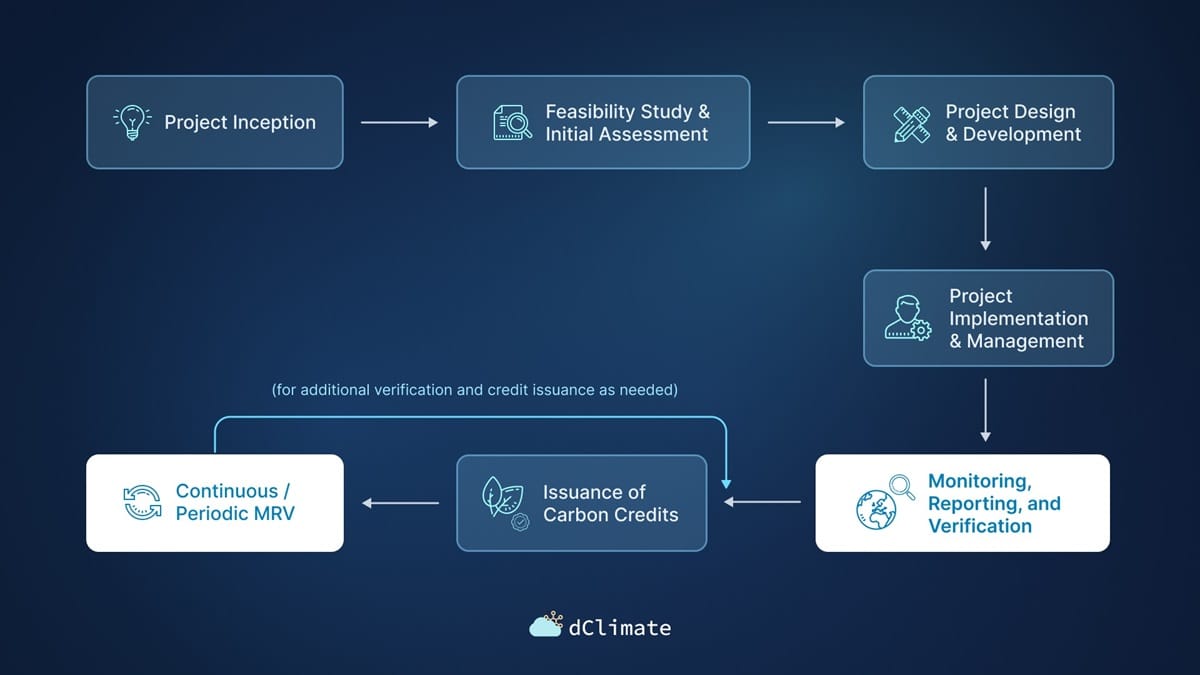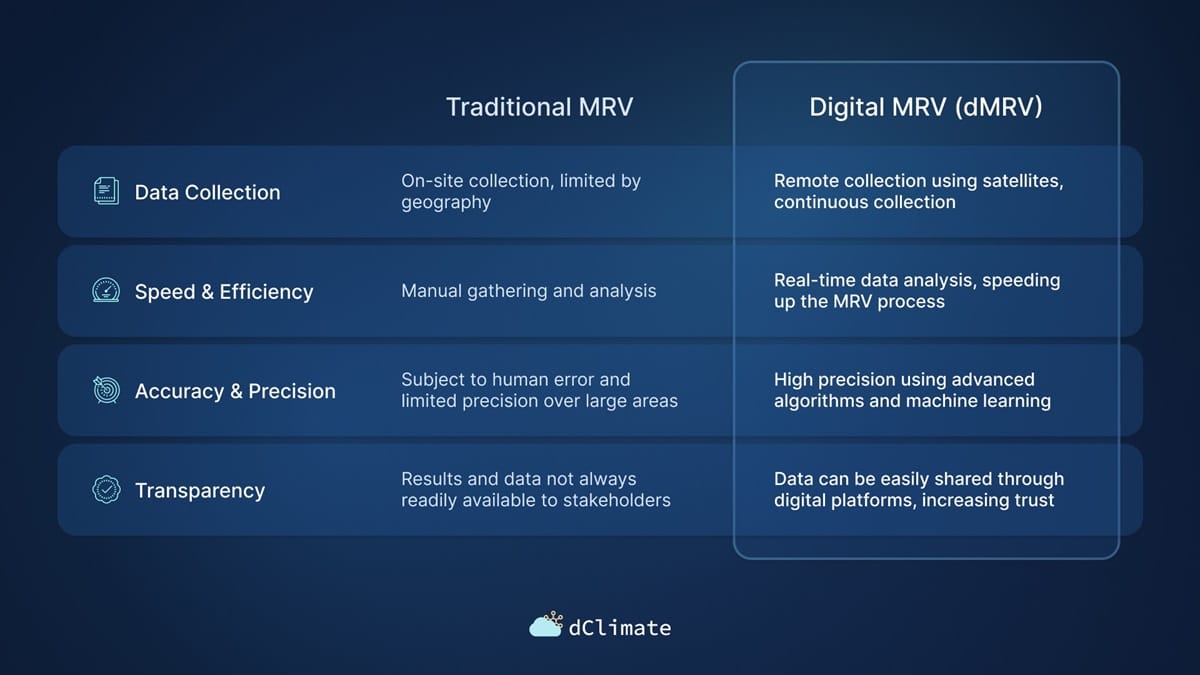MRV: the Key to Unlocking the Voluntary Carbon Market

Developing a carbon project involves a workflow that includes initial assessments and feasibility studies, a Project Design Description (PDD), and monitoring, reporting, and verification (MRV).
MRV is the process used to monitor and quantify how much CO2e is reduced or removed from the atmosphere by a project, transparently report these findings, and have them independently verified to ensure their accuracy and to validate the issuance of carbon credits by a standard like Verra or Gold Standard. While the design and execution of a project are essential, the ongoing MRV process is critical for evaluating the precision of emission reductions (and the corresponding issuance of carbon credits) and ensuring the project’s social and environmental impacts.

MRV: the Cornerstone of the VCM and Carbon Credit Project Development
MRV is central to project development and functions through a series of rigorous steps:
- Monitoring refers to the systematic collection of data and information regarding the implementation, performance, and impact of a project over time. It gathers quantitative and qualitative data to assess its performance against its objectives, and continuous monitoring allows for the identification of areas where the project could be optimized or adjusted.
- Reporting: Requires compiling the measured data into comprehensive reports detailing the methodologies used, the calculations for emission reductions, and the project's overall impact. These reports are prepared by project staff and shared with relevant standards and stakeholders (investors, project proponents, regulatory bodies, the general public, etc.).
- Verification: An independent third-party auditor (a Verification and Validation Body, or VVB, approved by standards) reviews the reported data and the project's claimed emission reductions to ensure accuracy and compliance with the relevant project's standard. This involves site visits, data cross-checking, and validation of methodologies.

A recent study by BGC indicated that a reliable MRV system is a key consideration for buyers when purchasing carbon credits with more than 90% of purchasers considering MRV to be a crucial aspect of their decision-making process. With increasing scrutiny on carbon offsets, buyers are eager to guarantee that the credits they acquire can demonstrate tangible impacts and withstand accusations of greenwashing.
Digital MRV: a New Era
Traditional MRV processes have historically been human-led, including various manual tasks such as on-the-ground data collection, manual entry of data, and direct observations by experts to assess project impacts and validate emission reductions.
Digital MRV (dMRV) represents an innovative approach to addressing the inherent challenges of traditional MRV processes in carbon projects and to addressing buyers' quality requirements.
Understanding dMRV and its Applications
Recent methodological updates highlight Digital MRV's role and potential in boosting the voluntary carbon market's (VCM) efficiency, accuracy, and integrity. Digital MRV leverages cutting-edge digital technologies, including artificial intelligence (AI), machine learning (ML), remote sensing, and Internet of Things (IoT) devices (such as smart meters for improved cookstoves).
- Artificial Intelligence (AI): AI applies complex algorithms to analyze extensive data sets, identify patterns, and compute emission reductions. It facilitates tasks such as learning, decision-making, and problem-solving.
- Machine Learning (ML): A subset of AI, ML uses data to teach computers to recognize patterns and make decisions without explicit programming. It improves predictions of project impacts, streamlines reporting, and aids in carbon credit verification.
Using data from various trusted sources, AI and ML enhance project outcome predictions and design. They automate MRV processes like real-time monitoring of emission reductions, report generation, and early anomaly detection.
- Remote Sensing: This technology utilizes satellite imagery and drones to monitor project areas from a distance, eliminating the need for physical presence. For example, it can monitor land use, forest cover, and environmental changes across large, often inaccessible areas, thus supporting precise measurements like biomass changes and afforestation efforts.
- Internet of Things (IoT) Devices: IoT integrates sensors and technologies into physical objects, enabling them to collect and share data. These devices monitor real-time environmental conditions (e.g., CO2 levels, temperature, humidity).

Addressing Traditional MRV Challenges
While traditional MRV is necessary to ensure the integrity of carbon credits, it is prone to several challenges. Human data collection, calculation, or reporting errors can lead to inaccuracies in estimating emission reductions. Additionally, the need for skilled labor and extensive logistical support makes the traditional approach costly, time-consuming, and difficult to scale, especially in remote areas.

Enhancing the efficiency, accuracy, and cost-effectiveness of MRV processes is essential for expanding the scope of carbon credit projects, ensuring their sustainability, and maximizing their environmental and social impacts.
Digital MRV aims to address these challenges by employing automated data collection methods via technologies that provide more accurate and consistent data while reducing the potential for human error in calculations and interpretations. For example, AI and machine learning algorithms further enhance data analysis, improving accuracy and reliability.
Moreover, Digital MRV is more cost-effective as it minimizes the need for on-the-ground personnel and reduces travel and logistical expenses associated with traditional MRV processes. By enabling real-time or near-real-time data collection and analysis, Digital MRV significantly accelerates the verification process, leading to quicker issuance of carbon credits.

A notable distinction between traditional and digital MRV methods is highlighted by their respective bandwidth for project verification. According to SustainCert, an approved VVB, an auditor utilizing conventional manual verification can assess between 100 to 150 projects per year, while in contrast, with dMRV technologies, an auditor's efficiency dramatically increases, allowing for the verification of 10 projects each day.
Baseline Approach: Another Differentiating Factor
The baseline establishes the "business-as-usual" scenario used to estimate the expected carbon emissions that would have occurred without the project's implementation. The difference between the carbon emissions under the baseline scenario and the actual emissions under the project determines the amount of carbon credits that can be issued during the initial crediting period.
While the two MRV methods differ in several ways, Digital MRV's ability to provide real- to near-real-time baseline data is a particularly notable differentiating factor. This enables it to offer timely insights and verification compared to the typically slower processes of traditional MRV.
Static Baseline
Traditional MRV processes rely on static baselines based on assumptions and data available at the project's outset, forecasting expected emission reductions over a predefined period. This approach could improve its ability to adapt to unforeseen environmental changes such as wildfires, disease outbreaks, or unplanned harvesting activities. This inability can lead to inaccuracies in estimating a project's real carbon impact on emission reductions.
Dynamic Baselines
The dynamic baseline approach introduces a shift by allowing the baseline to be updated with new observed data at each verification event. This approach calculates a project's climate benefits by comparing the project area's carbon emission benefits to a control group—a set of similar but unprotected forest plots, for example. By assessing the differences between the protected and unprotected regions over time, the dynamic baseline method provides a more accurate reflection of the actual impacts of conservation efforts.
Dynamic baselines offer:
- Real-Time Adaptability: One of the primary advantages of the dynamic baseline methodology is its ability to adapt in real time to changes in environmental conditions and project circumstances. Unlike static baselines, fixed at the project's inception, dynamic baselines can be continuously updated with new observed data at each verification event. This adaptability ensures that the estimated climate benefits of the project remain accurate and current, even in the face of unforeseen events.
- Enhanced Accuracy: The dynamic baseline methodology improves the accuracy of carbon credit calculations by allowing continuous updates based on observed data. Dynamic baselines provide a more nuanced and up-to-date understanding of the project's actual impact on emission reductions.
- Improved Additionality Case: Additionality is a critical concept in projects, referring to the idea that emission reductions achieved by the project would not have occurred without the project's intervention. The dynamic baseline methodology offers improved proof of additionality by comparing the project area's carbon benefits to a control group of similar but unprotected regions. By demonstrating that the project's impacts exceed what would have occurred under a business-as-usual scenario, the dynamic baseline methodology strengthens the case for issuing carbon credits and supports the project's overall credibility.

Two Complementary Approaches for One Objective
The integration of dMRV into the VCM marks a significant leap forward and makes it a readily available tool for scaling the VCM. While traditional MRV has laid the groundwork, dMRV's dynamic baselines and automated processes offer enhanced accuracy, efficiency, and real-time data analysis. This novelty also facilitates the creation of adaptive tokenized carbon credits.
By embracing dMRV, stakeholders across the VCM can work together to unlock its full potential. Standards, project developers, countries, VVBs, investors, and buyers can collectively contribute to establishing robust verification frameworks that leverage the strengths of both traditional and digital approaches. We can build a more transparent and reliable VCM through collaborative efforts, accelerating progress towards a sustainable future.
🌐 Check out our website, products, and blog
💽 Explore 40+ TB of free climate data via our data marketplace and API
📰 Sign up for our bi-weekly newsletter
🥳 Join the community: Twitter | LinkedIn | Discord | Telegram | YouTube

